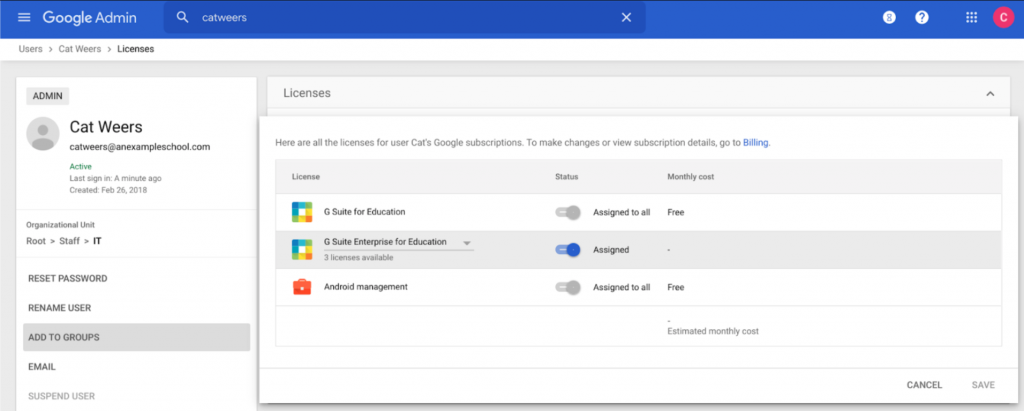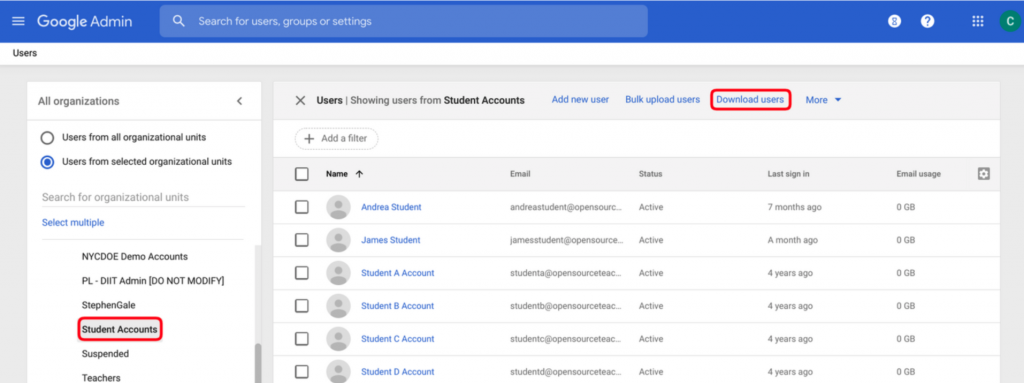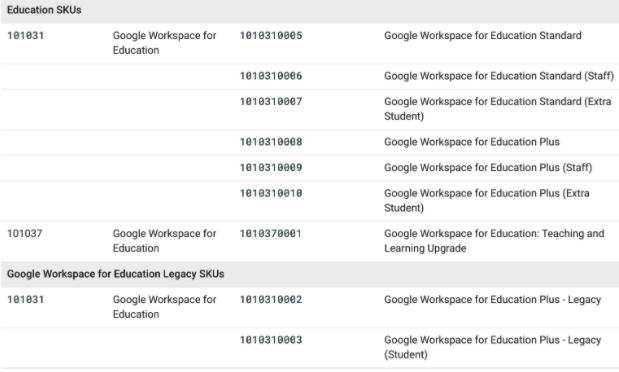Google Workspace for Education Plus (formally G Suite Enterprise for Education) provides institutions with a suite of communication and collaboration tools along with advanced security features to enhance security, teacher instruction, and student learning. Last year, 7,621 educational organizations found invaluable benefits from the Google Workspace for Education Plus edition features such as:
-
Advanced Security and Analytics
-
Enhanced Meet Functionality
-
Originality Reports
The enhanced Google Meet abilities are a big reason administrators select Education Plus for their digital infrastructure. When institutions purchase an Education Plus subscription, they also receive “Full Domain Licensing” that requires management to assign a license to the right users who need those enhanced functionalities (recording, live stream, breakout rooms, noise cancellation, Q&A, polls etc.). In most cases, instructional staff receive an Education Plus license along with specific office staff, admins, and other key stakeholders. However, there are a few factors to keep in mind when identifying who needs a license before determining how to allocate them.
Do students need a Google Workspace for Education license?
Again, Google Workspace for Education Plus features are beneficial to instruction and learning. The Google Meet functionalities, for example, are great for teachers to utilize in the Google Classroom. Administrators often question whether or not students need a Google Workspace license because of the permissions that come with them. According to Amplified IT’s team of experts, it is highly recommended that institutions allocate them to students as well.
Download a full list of Education Plus features to find out what requires a license to function for staff or students
Student licenses should be assigned for institutions to leverage several security features such as Context-Aware Access, Gmail Security Sandbox, and for device management (Windows 10 and Advanced Mobile Device Management), which is user- (not device) based. For administrators who plan on exporting the Gmail logs in BigQuery, it requires a license even though the regular admin logs do not. Another configuration that requires a student license is Data regions, which allows institutions to determine where their cloud data is stored.
There are other features in the Google Workspace roadmap that require a student license, but administrators don’t have to worry about permissions. The only feature that an Education Plus student license allows students to initiate and access is Cloud Search, a core service, from the Apps Launcher or by going to cloudsearch.google.com Students may recognize features used by teachers like originality reports, but student licenses will not enable any enhanced Meet features (ex breakout rooms, live streaming, Q&A, Polls).
Pro Tip: If the recording setting is ON for your student OUs, they will now be able to use the record functionality with an assigned Google Workspace for Education Plus license. This is a recent change so if you have had the service for some time, you may want to go into your admin console and check the setting for recording for students and decide if you want that ON/OFF.
What are the “gotchas” to avoid for Education Plus licenses?
Before assigning licenses, Google Workspace admins want to ensure their process is efficient by understanding a few “gotchas” that will save them time and energy if avoided.
The key “gotchas” are:
-
Auto-assigning by OU will assign licenses to all users in that OU, including suspended users. The auto-assign method is NOT recommended, more details in the auto-assign section below.
-
When a user is suspended, their Education Plus license must be removed as well, but it can be reused later.
-
The only ways to license by group are GCDS, GAM/APIs, or Amplified IT’s licensing tool (for AIT customers only).
How to assign licenses to users?
When institutions have determined who needs access through licenses, there are a few ways admins can go about assigning them to users.
1. Individual user assignments and removal
To assign or remove Licenses for an individual user, navigate to the user page in the Admin console.
Click the checkbox next to the user and click “more” to assign/remove licenses. Admins can also click into the user’s profile, navigate to the licenses section, and toggle ON the license to assign. It will also show how many are available.
This method is great for institutions that only have a few users that need licenses or if they need to provide a user license quickly, but it will not be scalable for larger organizations.
2. CSV bulk upload
The bulk upload method works well for institutions with under 500 users that need to be assigned licenses. Admins can use a CSV file to bulk assign licenses, however, it will time out if you are trying to upload a large quantity. Another thing to note is the CSV method cannot be used to remove licenses from users.
To bulk assign, sign in to the Admin console and navigate to the user’s page. Click the cogwheel and manage licenses in the user list. Select new column > choose license and then click Save.
Click “download users” at the top of the screen.
Change “Select columns” to “All user info columns and currently selected columns” and click download.
Download and open the Google Sheet. Locate the column called “New Licenses.”
Enter the product/service ID for the license you wish to apply. The SKUs are below:
Once the changes have been made to the file, save it as a CSV, return to the users section and click “bulk upload users.” Ensure the SKU numbers are entered in the AJ or New Licenses UPLOAD column (not the read-only column, which is a common mistake).
For other common errors, see this Google Help article.
3. Auto-assign license by OU
This method is effective for student licenses because students are in the same OU, but doesn’t often work well for administrator and teacher licenses since some staff users do need a license applied to them.
If institutions have suspended students in an OU with active students that require an Education Plus license, admins are going to want to move them to a suspended OU before assigning new users a license otherwise the auto-assign will allocate licenses to suspended users as well.
Admins should proceed with caution anytime they use auto-assign because it may attempt to apply more licenses than available. This will lead to the domain running out, and the need to spend time analyzing and removing individual licenses from users who shouldn’t have them.
4. GAM
For admins who are comfortable using GAM, they can use some general commands to assign and remove licenses by either user, OU, or even group while eliminating suspended users.
Some example commands are below. NOTE: These are for the Google Workspace for Education Plus- Legacy editions (previously G Suite Enterprise for Education). See the full list of updated SKUs here.
Add license to anyone in the Staff OU that is not suspended
gam print users query “orgUnitPath=’/Staff’ isSuspended=false” | gam csv – gam user ~primaryEmail add license 1010310002
Add license to anyone in the Student OU that is not suspended
gam print users query “orgUnitPath=’/Students’ isSuspended=false” | gam csv – gam user ~primaryEmail add license 1010310003
Remove license from anyone on the domain that is suspended (Staff License)
gam print users query “isSuspended=true” | gam csv – gam user ~primaryEmail delete license 1010310002
Remove license from anyone on the domain that is suspended (Student License)
gam print users query “isSuspended=true” | gam csv – gam user ~primaryEmail delete license 1010310003
Create a CSV of all users who have been assigned an Education Plus license
gam print licenses products 1010310002,1010310003 > licenses.csv
5. GCDS to assign licenses
If admins are already using GCDS for user provisioning, this is the best method to use for assigning licenses. It’s dynamic and can add/remove licenses based on Group membership.
Nested groups can be used. First, admins need to ensure they are on the latest version of GCDS, 4.7.6 as prior versions do not include the Google Workspace SKU in the license tab. They will also want to simulate any changes in the GCDS Configuration Manager prior to ensuring there is no unintended impact to your domain. Lastly, they will need to have auto-assign licensing turned OFF in the Admin console. If additional help is required with getting GCDS with Amplified IT, institutions will need a support contract. Our team can help admins customize and configure GCDS to assign their Education Plus licenses.
When purchasing the Google Workspace for Education Plus edition, it is important for institutions to appropriately allocate their domain licenses to provide administrators, teachers, and students with the access they need for management, instruction, and learning.
If you have purchased Education Plus from Amplified IT, we can help with your licensing. We offer our reseller account customers access to a tool that can be used to assign licenses to users by group and run on a schedule. We also have support available for those who have purchased a support contract with us. Our experts will find solutions to challenges you may face with the license application, security center, originality reports, advanced Google Meet features, and more. Check out our Support Stacks service to learn how you can get the most out of your support hours.
For support with licensing, using your support hours, or obtaining a support contract, email us at support@amplifiedit.com.
-

Catherine Weers
Onboarding & Engagement Consultant -
About the Author:
Catherine lives in Virginia Beach, walking distance to the Chesapeake Bay where she is Amplified IT’s Google for Education Onboarding and Engagement Consultant. Catherine joined the Amplified IT team in 2017 after serving in public schools for 13 years as a teacher in addition to various technology roles. Her current role as Onboarding and Engagement Consultant allows ample opportunity to empower schools, while sharing best practices to get the most out of the cloud solutions they adopt. In her spare time, you can find her at the beach with her family, likely chasing her 2 young daughters and petting all the dogs.








